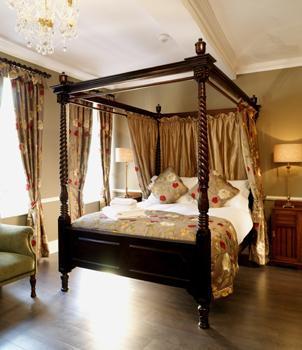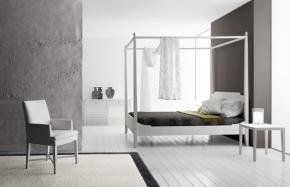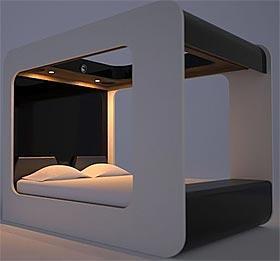Poster beds
Post from EditorialsThe four-poster bed is a symbol of elegance, sophisticated style and precious capable of enriching the room with refined lines and unique shapes.
History of poster beds
The term is derived from the Latin noun lectus bed, itself derived from the Greek lèchos items, ie bed, couch or lèktron, therefore the path history in a more functional way.
Although changed in size and materials it has always been an alcove in which to take refuge.
In prehistoric times the bed was built with piles of leaves or straw. The evolution of this furniture came through Mesopotamia, Egypt and Greece, countries in which they began to realize couches with tissues stuffed with wool, for people of noble lineage.
In the houses of the thirteenth and fourteenth centuries the bedroom became the main room. Its role was not only of being a place of rest, but also an environment where you can talk and offer hospitality. The bed was formed by a frame in wood with the heads of the same height and inserted on a pedrella lifted up from the floor; it was often separated by a curtain from the rest of the room. During that period in the royal families of Northern Europe were born the pillow and the poster beds, only filled with goose feathers.
During that period in the royal families of Northern Europe were born the pillow and the poster beds, only filled with goose feathers.
The lower classes and especially the pastors began to use wool mattress; who did not have sufficient resources to purchase it was forced to sleep on four planks of wood on two sawhorses and a big bag full of straw.
Only with the discovery of America, and with the beginning of the cultivation of corn plants, they began to use plant leaves to stuff mattresses.
When the Baroque period which tended to gigantism, was finally over, decorating with rich gilding and massive carvings typical of the bed à la duchesse and of the eighteenth century Rococo period, where this furniture became smaller and cuteness in the decorations but with cup-shaped form as in the spread of bed d'ange, we arrive at the end of the eighteenth century.
With the advent of Neoclassicism, where it became austere, it will be carried out in dark wood and decorated with gold or brass applications.
A typical example of the latter period were the beds: en bateau, à l'Empire, à l'antique, à la turque, à la màridienne.
The nineteenth century and the advent of Art Nouveau finally will mark the decay of decorum artifact and the birth of elegant bedding made of wrought iron.
The beginnings of the twentieth century opened the door to new forms of beds made from natural materials used by man to ensure a good rest.
Today to choose the right one, we can use technology and the evolutionary advances also apply to the four-poster bed, no longer seen as a bulky monumental piece of forniture.
Features of four-poster bed
Romantic, fairy-tale atmosphere of the protagonist, is a symbol of elegance, sophisticated style and precious able to enrich the bedroom with the refinement of exclusive lines and shapes ...
All of this is the four-poster bed, almost like a cradle that protects us and carries us into relaxation, perfect for the master bedroom.
This type of bed can be made of both wood and iron and is characterized by a structure that overhangs the mattress, and to which are attached curtains of various kinds. There are several models of four-poster bed to adapt in the best way for any type of bedroom.
There are several models of four-poster bed to adapt in the best way for any type of bedroom.
The four-poster bed in classic style is obviously the more widespread. These are beds that appear to come directly from magical and far times.
They are large and very high structures characterized by simple yet very romantic features. In fact, the structures can be finely decorated with floral motifs or small games of lines.
Models of four poster beds
Romantic, delicate, regal: Rebecca is the bed of the collection Taormina by Bizzotto furniture.
A magnificent and imposing four-poster bed in white and refined taste, enhanced by the play of light and shadow that move along the base.
The latter is in cherry antique white pinstripe, decorated with a floral pattern in relief.
The headboard is upholstered in soft leather Kabuki Ivoire. The bed is available in various sizes. No Mobile De Baggis is solely the result of the work of the machines, the most delicate and important phases of the work are still entrusted to the hands of experienced carpenters and masters of art.
No Mobile De Baggis is solely the result of the work of the machines, the most delicate and important phases of the work are still entrusted to the hands of experienced carpenters and masters of art.
There are numerous proposals for the bedroom, such as four-poster bed Fir Night of the line built in solid pine and painted with water colors in 5 finishes and 35 colors, which allow you to create atmospheres in line with your own needs, romantic and poetic, or current and dynamic.
The modern four-poster beds are characterized by being very low and have well-defined geometric lines and clean.
Even the structures to support the curtains, which in this case are positioned mainly in the upper part, are simple and geometric, without therefore any type of decoration.
Some models of the four-poster bed can be considered as real pieces of design. How to Lando, who proposes a bed more aesthetically simple, but with great visual impact.
How to Lando, who proposes a bed more aesthetically simple, but with great visual impact.
Top and sides framed and methods of joints enhance the use of the fact that solid wood, combined with extreme attention to detail in processing, are the main features of the collection Casalando.
To further enhance a noble materials such as solid cherry wood is sandblasted finishes offers. This, combined with a range of traditional and bold colors, making the collection a contemporary look.
Canopy bed technology
 Hi-Can, created a new concept of the classic and ultra-modern four-poster bed, by designer Edoardo Carlino in collaboration with Prof. Maurizio Muzzupappa.
Hi-Can, created a new concept of the classic and ultra-modern four-poster bed, by designer Edoardo Carlino in collaboration with Prof. Maurizio Muzzupappa.
Hi-Can: High Fidelity Canopy consists of a comfortable bed differentiated from others by its futuristic look.
Its technological structure is equipped with a retractable fabric that allows you to watch TV through a video projector placed on one side of the bed.
Do not miss a media center computer, the stereo system with speakers of last generation, a soft lighting system, a control unit to controll the environment and the predisposition to add a game console.
80837 REGISTERED USERS










